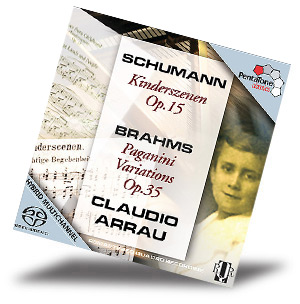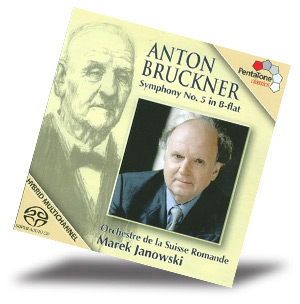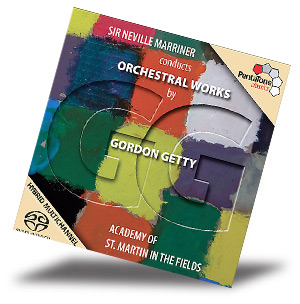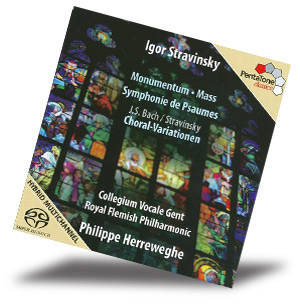
June 2010
PentaTone Classics: Reveling in Surround Sound
 Formed in 2001 by executives
from Philips Classics together with Polyhymnia International, audiophile
label
PentaTone Classics
was born near the beginning of SACD’s initial launch. It released some
of the best recordings in the then-new format and has continued to
produce SACD titles that pair distinguished artistry with perfectly
matched sound. The company is all about multichannel sound and hybrid
SACD. Formed in 2001 by executives
from Philips Classics together with Polyhymnia International, audiophile
label
PentaTone Classics
was born near the beginning of SACD’s initial launch. It released some
of the best recordings in the then-new format and has continued to
produce SACD titles that pair distinguished artistry with perfectly
matched sound. The company is all about multichannel sound and hybrid
SACD.
Philips had already explored multichannel sound in the 1970s with their
“quad” recordings, named for their number of channels, which were
arranged as 4.0 (two front and two rear). They were able to make
incredible quad master tapes in those days, but getting the sound onto
vinyl was difficult, if not impossible. There were two competing systems
for quad, and neither did a good job of recreating the sounds on the
master tape. But since it can handle multichannel recordings, SACD is a
natural for 4.0, and PentaTone continues to release its RQR (Remastered
Quad Recordings) series using the Philips quad masters as source
material. These recordings make it possible to hear legendary artists
like Claudio Arrau, Leopold Stokowski, Bernard Haitink, Quartetto
Italiano, Sir Colin Davis, and I Musici in recorded sound that compares
with, and often surpasses, the engineering of today.
PentaTone also has a series of
new recordings presented in 5.1 sound and recorded with the highest
standards available. The label has assembled its own stable of renowned
performers, including Kent Nagano, Yakov Kreizberg, Mikhail Pletnev,
Alexander Vedernikov, Sir Neville Marriner, Paavo Järvi, Pepe Romero,
Julia Fischer, Vesko Eschkenazy, Mari Kodama, The Netherlands
Philharmonic Orchestra, the Concertgebouw Chamber Orchestra, The Russian
National Orchestra, The Wiener Symphoniker, the Deutsche
Kammerphilharmonie Bremen,
the Bolshoi Opera, and many others. PentaTone is pursuing a complete
cycle of Shostakovich symphonies with the Russian National Orchestra and
a complete cycle of Dvorak symphonies with Kreizberg and the Netherlands
Philharmonic. PentaTone has also completed a set of Beethoven symphonies
with Philippe Herreweghe and the Royal Flemish Philharmonic, and the
label has come to the U.S.
for recordings with Marek Janowski and the Pittsburgh Symphony,
including a cycle of the complete Brahms symphonies.
Except for a special series of
historic radio broadcasts by the Saint Louis Symphony, all PentaTone
recordings are single-inventory hybrid SACD. That means you can buy the
same disc, whether you’re listening to two-channel Redbook or
six-channel DSD. This approach seems to baffle most American companies,
except for Chesky, perhaps for fear of confusing the consumer. It could
also explain why, in Europe,
the discs are generally known as
SA-CD instead of
SACD. It’s a small
difference, but it demonstrates that the super audio part exists
peacefully with the more familiar CD.
I’ve
found all PentaTone recordings to set outstanding performance and audio
standards. I listen to them on an Oppo universal Blu-ray player in
multichannel mode, but I also recommend them as Redbook CDs. Here are
four recent releases:
Schumann:
Kinderszenen
Brahms:
Paganini Variations
Claudio Arrau
PentaTone PTC 5186 170
Format: Hybrid Multichannel SACD
Musical Performance: ****
Sound Quality: ****1/2
Overall Enjoyment: ****
 This
is one of the RQR releases that lets us hear a master musician from the
past century in brilliant quadraphonic sound. Claudio Arrau was a
patrician among pianists of his day, and he brings elegance, class, and
lyricism to these familiar keyboard compositions. His pacing is either
leisurely without being slow or fleet without being frantic, and there’s
a comfortable satisfaction in hearing his performances. The famous
“Traumerei,” from the Kinderszenen,
is a piece that almost every pianist, amateur or professional, has taken
on at some point in their studies. Arrau plays it with an infectious
“just so” simplicity that could never be called indifferent. Recorded in
March 1974 at the Concertgebouw, its fabled acoustics add a golden glow
to sound that’s immaculately clean and clear. Kicking in the rear
channels ups the presence without calling any attention to the rear
speakers. This
is one of the RQR releases that lets us hear a master musician from the
past century in brilliant quadraphonic sound. Claudio Arrau was a
patrician among pianists of his day, and he brings elegance, class, and
lyricism to these familiar keyboard compositions. His pacing is either
leisurely without being slow or fleet without being frantic, and there’s
a comfortable satisfaction in hearing his performances. The famous
“Traumerei,” from the Kinderszenen,
is a piece that almost every pianist, amateur or professional, has taken
on at some point in their studies. Arrau plays it with an infectious
“just so” simplicity that could never be called indifferent. Recorded in
March 1974 at the Concertgebouw, its fabled acoustics add a golden glow
to sound that’s immaculately clean and clear. Kicking in the rear
channels ups the presence without calling any attention to the rear
speakers.
Bruckner:
Symphony No.5 in
B Flat
L’Orchestre
de la Suisse Romande; Marek Janowski, conductor
PentaTone PTC 5186 351
Format: Hybrid Multichannel SACD
Musical Performance: ****
Sound Quality: ****
Overall Enjoyment: ****
 L’Orchestre
de la Suisse Romande, under the baton of Ernest Ansermet, was one of the
most recorded orchestras from the 1950s to the early 1970s, but its
recordings have since been spotty and infrequent. PentaTone has tried to
change all of that by using the orchestra for a number of its
recordings, most prominently a complete series of Bruckner symphonies
helmed by Marek Janowski, the Polish conductor who now serves as the
orchestra’s music director. This is Janowski’s third recording in his
Bruckner series for PentaTone, the previous ones being the sixth and
ninth symphonies (PCT 5186 354 and PCT 5186 030). Janowski’s tempos are
fairly brisk, but he manages to get across the stately and heroic nature
of the music without wallowing. His overall reading is fresh, vital, and
alive, and the PentaTone engineers have created a rich, warm sound with
just the right amount of reverb to define the large recording space:
Victoria Hall in Geneva,
Switzerland. L’Orchestre
de la Suisse Romande, under the baton of Ernest Ansermet, was one of the
most recorded orchestras from the 1950s to the early 1970s, but its
recordings have since been spotty and infrequent. PentaTone has tried to
change all of that by using the orchestra for a number of its
recordings, most prominently a complete series of Bruckner symphonies
helmed by Marek Janowski, the Polish conductor who now serves as the
orchestra’s music director. This is Janowski’s third recording in his
Bruckner series for PentaTone, the previous ones being the sixth and
ninth symphonies (PCT 5186 354 and PCT 5186 030). Janowski’s tempos are
fairly brisk, but he manages to get across the stately and heroic nature
of the music without wallowing. His overall reading is fresh, vital, and
alive, and the PentaTone engineers have created a rich, warm sound with
just the right amount of reverb to define the large recording space:
Victoria Hall in Geneva,
Switzerland.
Gordon
Getty:
Orchestral Music (Overture
“Plump Jack,” Ancestor Suite,
Homework Suite,
Tiefer und Tiefer,
The Fiddler of Ballykeel,
Raise the Colors)
Academy
of St. Martin in the Fields; Sir Neville Marriner, conductor
PentaTone 5186 356
Format: Hybrid Multichannel SACD
Musical Performance: ****
Sound Quality: ***1/2
Overall Enjoyment: ****
 In
the
U.S.
we often assume that all great musicians starve for their art. And while
there’s no shortage of poor artists, there have also been quite a few
born with money. Felix Mendelssohn comes to mind, and now there’s Gordon
Getty. Yes, he’s from that
family of oil barons. He’s the son of J. Paul Getty, and he’s a whiz of
a financier and one of the richest men in America.
But that’s no reason to dismiss his music, which has proven to be
durable and quite likable. He writes in a thoroughly tonal manner,
claiming that he’s two-thirds 18th century. His fast pieces are
generally jolly, as in The Fiddler of
Ballykeel, and the slower ones a bit
wistful, as in the “Berceuse” from the
Homework Suite,
an orchestration of an earlier set of piano pieces. Marriner and his
accomplished orchestra find all the heartfelt simplicity in this music;
their performances are ideal. The pieces were recorded in a London
studio, so they don’t have the natural reverberation of a concert hall,
but the sound is still appealing for its clarity and excellent up-front
soundstage, which seems a bit wider than in PentaTone’s concert hall
recordings. In
the
U.S.
we often assume that all great musicians starve for their art. And while
there’s no shortage of poor artists, there have also been quite a few
born with money. Felix Mendelssohn comes to mind, and now there’s Gordon
Getty. Yes, he’s from that
family of oil barons. He’s the son of J. Paul Getty, and he’s a whiz of
a financier and one of the richest men in America.
But that’s no reason to dismiss his music, which has proven to be
durable and quite likable. He writes in a thoroughly tonal manner,
claiming that he’s two-thirds 18th century. His fast pieces are
generally jolly, as in The Fiddler of
Ballykeel, and the slower ones a bit
wistful, as in the “Berceuse” from the
Homework Suite,
an orchestration of an earlier set of piano pieces. Marriner and his
accomplished orchestra find all the heartfelt simplicity in this music;
their performances are ideal. The pieces were recorded in a London
studio, so they don’t have the natural reverberation of a concert hall,
but the sound is still appealing for its clarity and excellent up-front
soundstage, which seems a bit wider than in PentaTone’s concert hall
recordings.
Stravinsky:
Monumentum,
Mass,
Choral-Variationen,
Symphonie de Psaumes
Collegium Vocale Gent, Royal Flemish
Philharmonic; Philippe Herreweghe, conductor
PentaTone 5286 349
Format: Hybrid Multichannel SACD
Musical Performance: ****
Sound Quality: ****1/2
Overall Enjoyment: ****
 Through
his recordings on the Harmonia Mundi label, Philippe Herreweghe built an
enviable reputation as a conductor of baroque music. Over the past ten
years, the Belgian-born maestro has been leading a lot more music from
the romantic period, recording the complete symphonies of Beethoven for
PentaTone with the Royal Flemish Philharmonic, of which he is principal
conductor. Herreweghe founded Collegium Vocale Gent in 1979, and on this
recording of Stravinsky’s religious works he gets to lead both of the
organizations he’s partnered with. His readings are fleet, incisive, and
insightful, and both the chorus and the various instrumental
combinations that accompany it turn in first-rate performances.
Herreweghe’s reading of the Symphonie de
Psaumes (The
Symphony of Psalms) is particularly
exciting. The PentaTone engineers have provided close-to-perfect sound
that preserves the conductor’s clean and precise interpretations. The
presence is natural, and the front stage left-right separation is ideal,
as is the balance between singers and instrumentalists. There’s also
just the right amount of ambience in the rear speakers. This disc is a
certainly a keeper. Through
his recordings on the Harmonia Mundi label, Philippe Herreweghe built an
enviable reputation as a conductor of baroque music. Over the past ten
years, the Belgian-born maestro has been leading a lot more music from
the romantic period, recording the complete symphonies of Beethoven for
PentaTone with the Royal Flemish Philharmonic, of which he is principal
conductor. Herreweghe founded Collegium Vocale Gent in 1979, and on this
recording of Stravinsky’s religious works he gets to lead both of the
organizations he’s partnered with. His readings are fleet, incisive, and
insightful, and both the chorus and the various instrumental
combinations that accompany it turn in first-rate performances.
Herreweghe’s reading of the Symphonie de
Psaumes (The
Symphony of Psalms) is particularly
exciting. The PentaTone engineers have provided close-to-perfect sound
that preserves the conductor’s clean and precise interpretations. The
presence is natural, and the front stage left-right separation is ideal,
as is the balance between singers and instrumentalists. There’s also
just the right amount of ambience in the rear speakers. This disc is a
certainly a keeper.
. . . Rad Bennett
radb@soundstagenetwork.com
|

